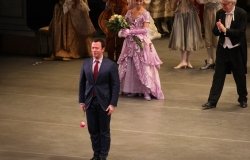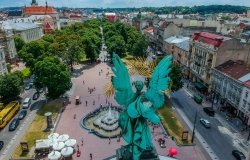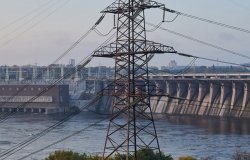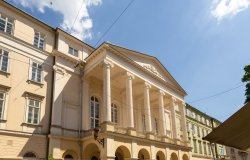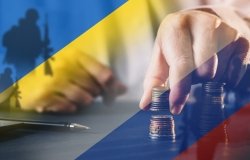
A blog of the Kennan Institute
Ukraine Quarterly Digest: July – September 2017
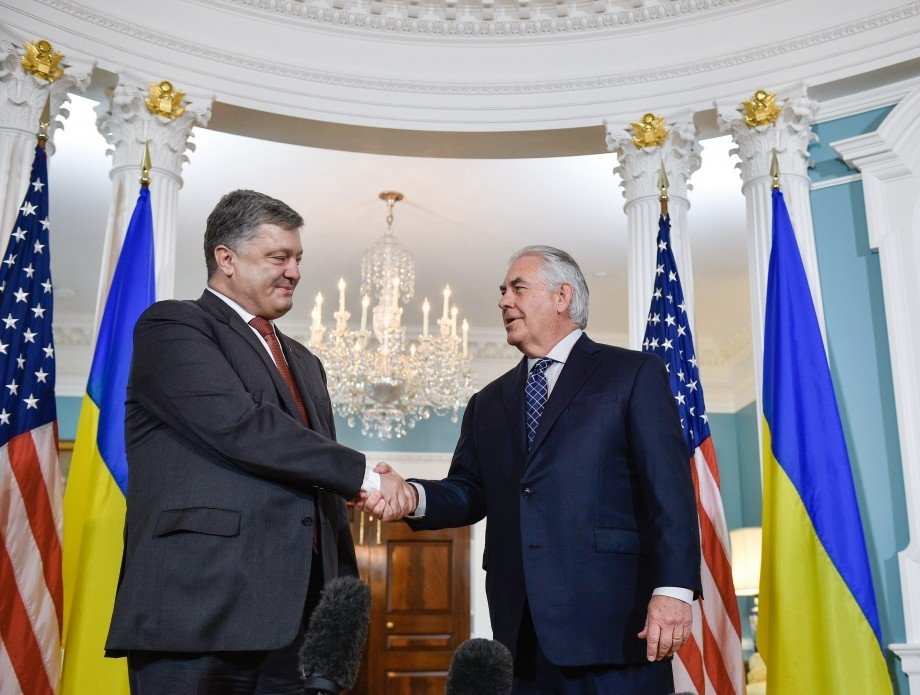
In the second part of 2017 calm generally prevailed in Ukraine in the foreign policy arena, with some light turbulence. The new law on education caused tension and discussion both inside Ukraine and among neighboring states. Though Ukraine-Western relations exhibited positive, even critical advances, especially in U.S.-Ukraine relations, Ukraine’s internal politics experienced some turmoil, chiefly related to Mikheil Saakashvili’s actions after President Poroshenko signed the decree revoking his Ukrainian citizenship and the response of the West, which saw in the decree a violation of international norms precluding the arbitrary cancellation of citizenship.
1. FOREIGN POLICY ISSUES
Ukraine-U.S. Relations
On July 9, U.S. Secretary of State Rex Tillerson visited Kyiv and met with President Petro Poroshenko. Before that meeting, Secretary Tillerson met with younger-generation leaders from government and civil society. With the young reformers, the secretary mostly spoke about battling corruption and the provision of international aid for Ukraine; with the president he discussed security issues and Ukraine’s territorial integrity. Battling corruption was also on the agenda during Poroshenko’s and Donald Trump’s meeting on September 21 in New York, where both presidents took part in the 72nd Regular Session of the UN General Assembly.
New U.S. Special Representative
On July 7, Secretary Tillerson appointed Kurt Volker, former U.S. ambassador to NATO, Special Representative for Ukraine Negotiations. Ambassador Volker and the U.S. ambassador to Ukraine, Marie Yovanovitch, accompanied by U.S. and Ukrainian officials, visited the Donbas. Mr. Volker said that the conflict in the Donbas was not frozen but a hot war.
Sanctions and Resistance to Russia’s Energy Influence
On July 27 the U.S. Congress passed, and on August 2 President Trump signed, the Countering America’s Adversaries Through Sanctions Act, which imposed new sanctions on Iran, North Korea, and Russia. The act also recognizes Ukrainian territorial integrity and Russia’s responsibility for the annexation of Crimea and the illegal invasion of eastern Ukraine and South Ossetia and Abkhazia in Georgia.
Section 257 of the act is dedicated to strengthening Ukrainian energy security, in part by helping Ukraine and other U.S. allies in the region reduce their reliance on energy imports from the Russian Federation. As the act states, Russia “uses [natural gas] as a weapon to coerce, intimidate, and influence other countries.” It should be noted that U.S. interest in strengthening Ukraine’s energy security is not a new development; it was among the key points enumerated in the United States–Ukraine Charter on Strategic Partnership, signed on December 19, 2008.
It is true that before 2013, Ukraine was critically dependent on Russian supplies of energy resources, services, and technologies. In that context, Russia was the sole supplier of gas to Ukraine. Since November 2015, however, Ukraine has imported gas only from the EU. Of course, most of that gas was supplied to the EU by Gazprom, but diversifying the delivery routes decreased opportunities for Russia to affect Ukraine and influence its policies. Much the same thing happened with nuclear fuel imports: before 2014, Russia was the only supplier, but later Ukraine started buying from Westinghouse’s Swedish division. In 2016 the share of Russian supplies was only 61 percent of Ukraine’s total imports of nuclear fuel, and Russia’s share continues to fall. It’s likely that diversification has also been responsible for the price decline: in 2013, Ukraine consumed 369.36 tons of Russia-sourced nuclear fuel, at a cost of U.S. $600.59 million; for 2016 those figures were 450.49 tons variably sourced at a cost of $548.7 million.
For many years Ukraine was self-sufficient with respect to coal supplies. But after the beginning of the military conflict in the Donbas, a region responsible for the greatest part of coal extraction in the country, Ukrainian companies had to import anthracite coal. To some extent Russia is also responsible for the disruption of coal supplies, as it is supporting and backing groups of armed separatists illegally acting in the Donbas who have seized control of coal mines and other enterprises in the region.
According to Section 257 of the 2017 U.S. sanctions act, the Government of Ukraine, in cooperation with the United States Agency for International Development and the U.S. secretary of energy and secretary of state, is to develop a plan to improve Ukrainian energy security. The plan is to be presented in early 2018. The act also stipulates an appropriation of $30 million during the 2018 and 2019 fiscal years for carrying out activities related to Ukrainian energy security. The Export-Import Bank of the United States and the Overseas Private Investment Corporation will play important roles in supporting key Ukrainian energy projects that contribute to the goal of achieving energy security. In addition, Section 257 prioritizes efforts to stop the NordStream 2 pipeline and increase exports of U.S. energy resources in order to support U.S. allies and create jobs in the United States.
U.S. Coal for Ukraine
President Poroshenko, during his visit to Washington, D.C., and his meeting with Donald Trump in June 2017, discussed the possible U.S. provision of coal supplies to Ukraine. Later, on July 31, the Ukrainian state-owned power-generating company Centrenergo PJSC and the privately held U.S. company Xcoal Energy and Resources signed a deal for 700,000 tons of Pennsylvania anthracite—the first-ever shipment of energy coal from the United States to Ukraine. The agreement was presented as a strong contribution to Ukrainian energy security by President Poroshenko and other officials. Though the price of $113 per ton for the first shipment was comparatively high, in Ukraine, the president is not responsible for managing the business deals of state-owned companies. The U.S. coal supplies story is different from the nuclear fuel one: as mentioned above, the latter has definitely proved beneficial, whereas the coal supplies story is attended by some uncertainty. This case was discussed earlier in more detail, including some thoughts on the political reasons to strike a deal.
The Pentagon
General James Mattis, U.S. secretary of defense and Pentagon chief, visited Ukraine on August 24, the Ukrainian independence day, and met with President Poroshenko. During the press conference following the meeting General Mattis and Ukraine’s president both spoke about priorities and negotiations in the Donbas, including the possibility of having a UN peacemaking mission there.
Ukraine-NATO Developments
On July 6, President Poroshenko signed a law (approved by parliament on June 8) to prioritize the integration of Ukraine with NATO. Ukraine now must move forward to meet NATO’s standards. Later, on July 10, Jens Stoltenberg, NATO’s secretary general, visited Ukraine to participate in the NATO-Ukraine Commission session. The main points of Stoltenberg’s address to parliament were not unique: along with other Western officials, he spoke of the need to battle the “cancer of corruption,” while also recognizing Ukraine’s progress in this arena. Mr. Stoltenberg promised that NATO would continue supporting Ukraine and would provide equipment to help Ukraine withstand cyberattacks; he also stressed the need to implement the Minsk agreements. During his visited he participated in the opening of the new NATO office in Kyiv.
Relations with the EU
On September 1, the EU-Ukraine Association Agreement, including the free trade provisions, came into full force (parts of it had been implemented before that date). A lot remains to be done to shape Ukrainian legislation in accordance with European laws, as stipulated by the agreement. About 600 European legislative acts must be implemented in Ukraine by 2025. The process is on track but behind schedule. According to the Ukrainian vice prime minister for European integration, in 2016 Ukraine was to implement 130 EU directives, but only 26 were completely implemented—a notable shortfall.
Canada-Ukraine Free Trade Agreement
The Canada-Ukraine Free Trade Agreement came into force on August 1. It was the second such agreement but the first to be signed and implemented after the Revolution of Dignity in 2013–2014. Increasing Ukrainian exports is of great importance, chiefly because of the decline in trade with Russia after the start of the Russian Federation’s aggression toward Ukraine. Key Ukrainian products that will benefit from a tariff-free access to Canadian markets include agricultural products, manufactured goods, ceramics, minerals, iron and steel, baked goods, and apparel.
New Law on the Language of Education
On September 25, President Poroshenko signed a new law on education that had been passed by parliament on September 5. Besides the list of changes mandated by the law, it caused tension with neighboring states because of the policy regarding the language of education. The law stipulates the full right and absolute freedom for national minorities to study in their native languages in the early school years. However, beginning with secondary schooling, the language of education should be the official one, Ukrainian. The logic behind this ruling was that representatives of ethnic minorities without a strong knowledge of Ukrainian would have difficulty living and building careers outside their ethnic communities. The larger framework within which the law was conceived was to provide equal rights in the future for all citizens, regardless of their ethnicity or national community. But the law has ignited a heated discussion inside Ukraine (see here for another article on this issue) and tension with neighboring states that have populations living in Ukraine, including Russia, Poland, Hungary, and Romania.
The Hungarian parliament has criticized the law, and the country lodged protests against it with the UN, the OSCE, and the EU. The main argument was that the law restricted the rights of Hungarians living in Zakarpattia oblast. On September 21, the Romanian president canceled his visit to Ukraine because of the law. The president of Moldova also expressed concern over the new language of education requirements. At the same time, some countries, such as the United States, supported the law, and some even supported the language policy paragraph, as Latvia did. However, by the end of 2017, Ukraine had managed to negotiate with neighboring countries on this issue, as the next quarterly update will discuss.
2. INTERNAL AFFAIRS
Saakashvili: From Love to Hate
On July 27, the State Migration Service of Ukraine announced that Mikheil Saakashvili’s citizenship had been revoked through a presidential decree canceling a previous decision granting partial citizenship. The formal cause for the decision was that Saakashvili had omitted mention of his previous convictions on his application for Ukrainian citizenship. Saakashvili said that the signature on the application was forged. However, he did not try to litigate the decision in court for a long time. And President Poroshenko, as was his custom, remained silent on the matter for some time and did not comment on signing the decree. One and half months later he said that law enforcement authorities had had to deal with Saakashvili’s behavior and actions, and that not signing the decree would have been a crime because of Saakashvili’s failure to provide truthful information on his citizenship application.
Saakashvili acquired Ukrainian citizenship on May 30, 2015—the same day that Poroshenko appointed him governor of Odesa oblast, a not particularly honorable position for a former president of a country. But it was obvious that he wanted (and still wants) to pursue a political career in Ukraine. A couple of days before his citizenship was revoked, on July 21, the Ukrainian Ministry of Justice registered the political Movement of New Forces, with Saakashvili as its head. Ukrainian elites did not like Saakashvili’s intention, mostly because of his tendency to criticize, his hot temper, and his unpredictability. However, according to Ukrainian legislation, Saakashvili could not run for president (ten years of residency in Ukraine is a prerequisite to became a candidate).
On November 7, 2016, Saakashvili resigned from the Odesa regional administration. He had not been especially successful in that role and blamed his failure on corruption, including at the top level. Despite his remarkable popularity when he first arrived in Ukraine, mostly because of his achievements in Georgia, it had fallen considerably by the time Poroshenko signed the decree. However, the revocation of Saakashvili’s Ukrainian citizenship acted to boost his popularity again, because some regarded the act as of a piece with Poroshenko’s attempts to strip his opponents of power and salience.
The arc of Proshenko’s friendship with Saakashvili may have found a mirror in Saakashvili’s political fortunes. Before the decision was made to cancel his citizenship, Saakashvili had never attributed corruption to Poroshenko personally or articulated any personal grievances with him. When the president did finally comment on the decision, he said it was just an answer to information from and a request by the State Migration Service of Ukraine. His framing it in this manner made it appear that he was just doing his job correctly. But to observers, it was clear that Poroshenko, who almost two years earlier had called Saakashvili his close friend and reliable partner, at that moment was annoyed with him.
The citizenship cancelation decree appeared when Saakashvili was not in Ukraine; he was traveling in the United States and Poland and intended to return to Ukraine despite losing his citizenship. On September 10, Saakashvili, accompanied by a group of members of parliament, civil activists, and journalists, attempted to enter Ukraine from Poland. Another group of sympathizers was waiting for him in Ukraine at the border control checkpoint. Police and the National Guardsmen were waiting there as well. The main task of those forces remained unclear, whether it was to ensure legal procedures were followed and to prevent disorder or to keep Saakashvili from entering Ukraine. However, the police forces and border troops did not abuse their powers, even though they could have legally used force insofar as Saakashvili and the others with him were violating border crossing procedures, and some of his companions sought to provoke officials by making disparaging remarks.
Once back in Ukraine, Saakashvili realized the risk of being sent back to Georgia by Ukrainian law enforcement authorities. Georgia had previously issued a few requests for the criminal extradition of Saakashvili (which, incidentally, undercuts Poroshenko’s argument, as the charges were publicly known at the time of Saakashvili’s application for ). However, Ukrainian authorities had refused all such requests. In early September Georgia’s General Prosecutor’s Office sent one more request. However, Saakashvili stayed in Ukraine and was not forced to go back to Georgia by Ukrainian authorities.
An aggravating factor in Saakashvili’s case was that he had violated legal procedures for entering Ukraine. Surrounded by his supporters, Saakashvili actually broke through the border without clearing customs and border control or adhering to standard protocols for entering Ukraine. That same day President Poroshenko called this step breaking the law, and Minister of Internal Affairs Arsen Avakov said that after the incident, Saakashvili had to register his entry into Ukraine in order to make his situation legal. So top Ukrainian officials refrained from escalating the incident at that time. However, a couple of people who had accompanied Saakashvili across the border were found guilty of violating the law. Later, on September 22, the court in Lviv oblast (close to the border control checkpoint) fined Saakashvili 3,400 UAH (about U.S. $125) for his illegal border crossing.
In sum, Saakashvili irritated a lot people through his “expressive” behavior and outspokenness, and he violated the law when crossing the border. He did not challenge the decision to revoke his citizenship in court for a long time. Nonetheless, in the third quarter of 2017 Ukrainian officials adopted a moderate stance toward Saakashvili and his actions.
Garbage Politics in Ukraine
On July 14, the city council of Lviv, the biggest city in western Ukraine, announced that the city’s garbage disposal problem was solved and the city had been cleaned of trash. Lviv had suffered from overflowing garbage collection sites for more than a year, after the city’s only landfill caught fire. However, it was not just a technical problem of garbage disposal. Rather, the situation resulted from a political clash between President Poroshenko and Lviv’s mayor, Andrii Sadovyi, who is also the head of the political party Samopomich (see here for more details on the case). The Lviv city administration suspected officials accountable to President Poroshenko of blocking the removal of garbage from the city. It appears that Poroshenko’s team expected the garbage debacle would destroy Sadovyi’s image as an effective mayor and a politician who stood in opposition to the president and his team. Prime Minister Volodymyr Groysman blamed Mr. Sadovyi for inefficient management, and members of parliament representing Poroshenko’s party even appealed to Sadovyi to resign; those requests stopped after the garbage issue was resolved.
Naftogaz and the Government: Mutual Recriminations
On September 19, two members of the independent supervisory board of the state-owned Ukrainian energy giantNaftogaz issued a statement announcing their intention to resign. Two weeks earlier another member had announced his wish to resign by the end of the month. That was remarkable news. Naftogaz is one of the biggest companies in Ukraine, certainly the country’s biggest energy operator, and in recent months the biggest taxpayer into state coffers. Moreover, the board members cited as one of the mainreasonsfor resigning the government’s obstruction of reforms. Prime Minister Groysmanrespondedthat Naftogaz was a monopoly and, in keeping with the EU guidelines along which Ukraine’s new gas market law was drawn up, had to be broken up despite any attempts to resist this move. Conflicts between the management of Naftogaz and Groysman are nothing new but equally are far from over, and are connected to political battles. You can read about this case in more detail in another article written by the author.
3. PROGRESS IN REFORMS AND SUCCESS STORIES
Ukrainian Banking System Reforms
The Ukrainian banking system recorded a profit in August. Total net profit during the first eight months of 2017 amounted to UAH 3.429 billion (about U.S. $129 million), the National Bank of Ukraine (NBU) said. In the same period in 2016 the banking system recorded a net loss of UAH 3.652 billion. Among the most important reasons why the banking system turned profitable was the clean-up policy pursued by the NBU during 2016–2017. As part of the process, PrivatBank, Ukraine’s largest bank, which faced a multibillion-dollar shortfall, was nationalized and recapitalized, and a new monetary policy targeting inflation was implemented. The results have been dramatic. In the first half of 2016, net losses from the Ukrainian banking system amounted to UAH 1.85 billion. In the first nine months of 2017, by contrast, Ukrainian banks generated UAH 1.41 billion in net profit.
Reform of Ukrainian Government Service
On August 18, the Ukrainian government adopted a couple of decisions that launched the reform of the government service system. The European Union will support this reform with a grant of more than €100 million. The reform stipulates starting new departments in ministries, to be known as directorates, that will aid in implementing reforms. Professionals and experts on reforms will be hired to work in the directorates. The reforms will start with pilot programs in ten current ministries and are expected to be completed by mid-2018.
4. THE SITUATION IN DONBAS
Occupied Territories without Electricity Supplies
On July 26, the single Ukrainian electricity transmission operator, the state-owned National Power Company Ukrenergo, stopped supplying electricity to the non-government-controlled areas of and Luhansk oblasts. The official reason for this step was that the electricity previously supplied to the uncontrolled areas had not been paid for. After the cutoff, the occupied territories were to be supplied by energy stations located inside those territories and directly by Russia.
New Pseudo-State?
On July 18, the leader of illegal militants in the non-government-controlled part of Donetsk oblast proposed the creation of a state, to be called Malorosiia (literally “Small Russia,” that is, comprising Ukrainian territories associated with Russian aggression). That illegal formation was to include nineteen other regions of Ukraine. As the separatists’ leader said, that should solve the “crisis.”
On the one hand, such statements by the separatists are not worth paying attention to; on the other hand, disregarding them could be interpreted as losing interest in the Ukrainian problem, which could lead to further destabilization. So the representatives of many countries made statements about the illegality of such intentions while also pointing that such statements didn’t merit attention. Later, the militants rejected the idea of establishing a pseudo-state.
The danger of such statements is that they can act like a mental virus and subtly infect one’s thinking. The idea can be raised again later, when it will somehow seem familiar rather than an outrageous proposition.
About the Author
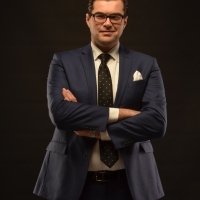
Andrian Prokip
Director, Energy Program, Ukrainian Institute for the Future

Kennan Institute
The Kennan Institute is the premier US center for advanced research on Russia and Eurasia and the oldest and largest regional program at the Woodrow Wilson International Center for Scholars. The Kennan Institute is committed to improving American understanding of Russia, Ukraine, Central Asia, the Caucasus, and the surrounding region though research and exchange. Read more


